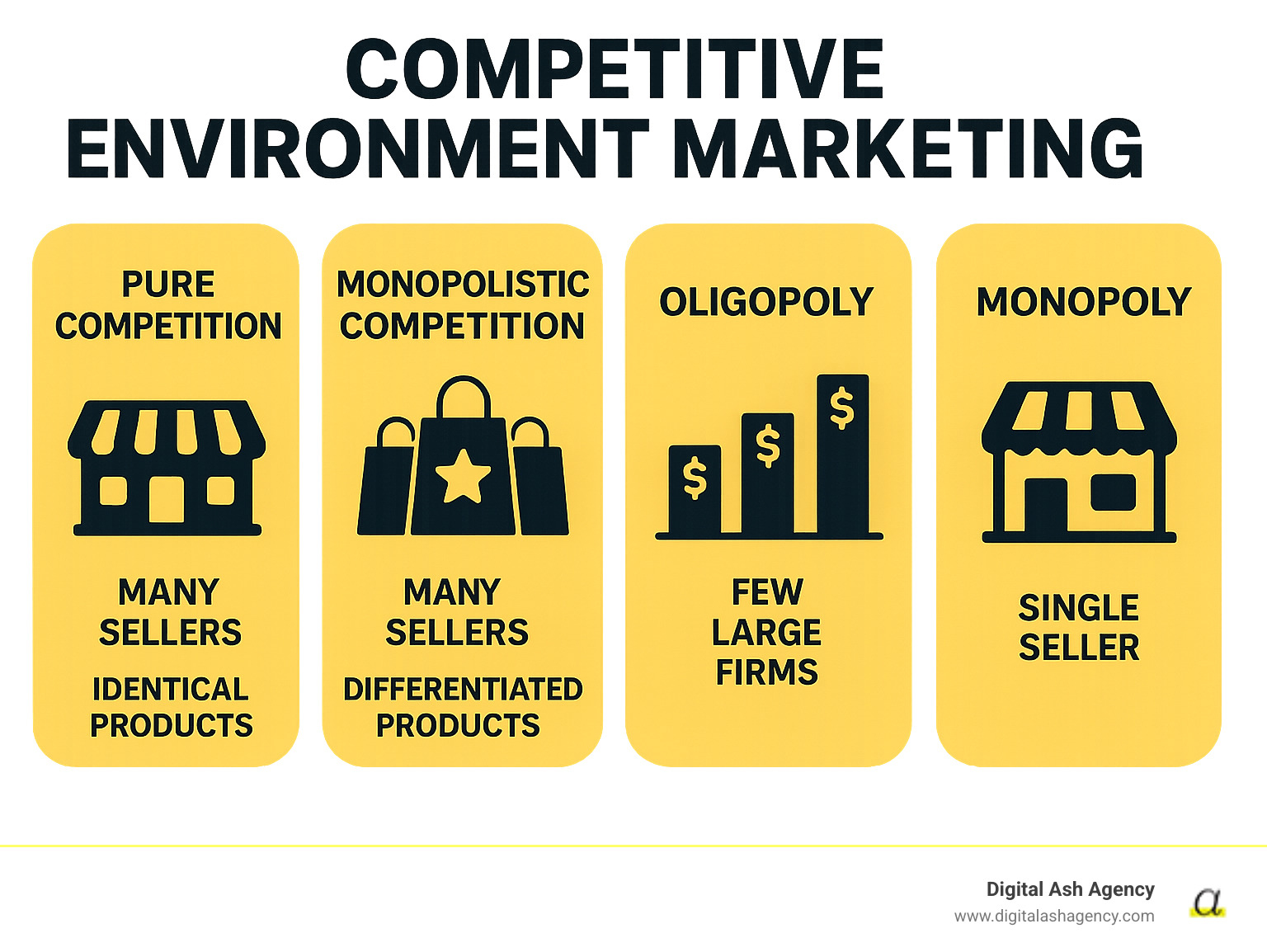
Why Understanding Competitive Environment Marketing Is Crucial for Your Practice
Competitive environment marketing is the strategic approach businesses use to promote their services in markets where multiple companies compete for the same customers. This requires understanding your competitive landscape, identifying your unique advantages, and positioning your business to stand out.
Key Components of Competitive Environment Marketing:
- Market Analysis: Understanding who your competitors are and what they offer.
- Differentiation Strategy: Identifying what makes your business unique.
- Positioning: How you present your business relative to competitors.
- Value Proposition: The specific benefits that set you apart.
- Customer Focus: Understanding why customers choose you over alternatives.
Whether you're a healthcare provider dealing with non-compete restrictions or a professional service building market share, this approach helps you steer crowded markets by focusing on what makes your practice different. Instead of competing on price, it emphasizes building genuine advantages through specialized services or a superior customer experience.
The reality is simple: every business operates in a competitive environment. You're always competing for your customers' time, attention, and budget against both direct competitors and alternative solutions.
I'm Ashley Gay, and I've helped my husband's medical practice generate $239,000 in the first 90 days despite enforceable non-compete agreements. My experience has shown me that the right positioning and differentiation strategies can overcome even the most challenging competitive restrictions.

What Is a Competitive Environment in Business?
A competitive environment is a marketplace where multiple businesses pursue the same customers. In this market structure, companies selling similar products or services use different strategies—like pricing, marketing, or unique features—to win over buyers. Think of it as a race where everyone is trying to cross the finish line first.
This business rivalry pushes everyone to improve. Competition acts like a personal trainer for businesses, forcing us to constantly get better. When we know customers have other options, we work harder to deliver exceptional value. This pressure drives innovation and keeps entire industries moving forward.
For customers, this is great news. When businesses compete, consumers get better products, more competitive pricing, and superior service because companies know that disappointed customers can easily go elsewhere. The impact on pricing is significant; businesses must consider what rivals are charging and justify any premium through added value.
If you want to dive deeper into this concept, check out this helpful resource on What Is the Meaning of Competitive Environment?.
Direct vs. Indirect Competition
Understanding the different types of competitors is key to your market strategy.
Direct competition is the most obvious—these are businesses offering the same product or service category to the same audience. If you're a dermatologist, your direct competitors are other dermatologists in your area. They solve the exact same problem for the same people.
Indirect competition is trickier but just as important. These businesses don't offer identical services, but they address the same customer need with substitute solutions. For example, a physical therapist specializing in back pain has other physical therapy clinics as direct competitors. But their indirect competitors might include chiropractors, massage therapists, or even online fitness programs that promise to solve back problems. They are all targeting people with back pain, just with different approaches.
Understanding both types gives you a complete picture of your marketplace. It helps you see not just who does what you do, but who else is solving your customers' problems. This broader view can reveal new opportunities and help you position your practice more strategically.
When developing your competitive environment marketing strategy, mapping out both direct and indirect competitors is crucial. You need to understand the full ecosystem of solutions your customers might consider to anticipate market shifts and identify unique positioning opportunities.
Understanding the Competitive Landscape: Types and Factors
The competitive landscape is shaped by several key factors: the number of sellers in the market, the degree of product differentiation, the height of barriers to entry for new competitors, and the market power individual businesses have over pricing.

This spectrum shows how market power changes across different environments. Understanding where your practice fits is essential for crafting the right competitive environment marketing strategy. The Small Business Administration offers valuable insights on this topic through their Market Research and Competitive Analysis for Small Business Advantage resources.
Let's walk through the four main types of competitive environments:
Pure Competition
In a purely competitive market, there are many sellers offering identical products. No single vendor has the power to set prices, making them price takers. Success depends on operational efficiency and keeping costs low. In the U.S., agricultural markets for commodities like corn and wheat are a prime example. Individual farmers must accept the current market price because their product is indistinguishable from others.
Monopolistic Competition
This environment features many sellers with differentiated products. While the services might be similar, each business stands out through branding, quality, location, or customer experience. This is common for local restaurants, hair salons, or medical practices in larger cities. For example, one family practice might specialize in pediatrics, while another focuses on geriatrics. Smart marketing is key here, as differentiation allows for some pricing flexibility and customer loyalty.
Oligopoly
An oligopoly is a market dominated by a few large firms. The barriers to entry are typically high, and the companies are highly interdependent—one's actions directly affect the others. The U.S. telecommunications industry is a classic example, where a handful of major carriers control the market. Competition often focuses on innovation, marketing campaigns, and customer service rather than aggressive price wars.
Monopoly
A monopoly exists when a single seller controls the entire market with a unique product and no close substitutes. True monopolies are rare in the U.S. due to antitrust laws, but natural monopolies like public utilities are common. In many regions, you have only one choice for electricity or water service. These companies are typically heavily regulated to prevent them from abusing their market power.
How to Analyze Your Market for a Competitive Edge
Understanding your competitive environment is a strategic imperative. A thorough market analysis helps identify opportunities, understand threats, and make data-driven decisions that propel your practice forward. To gain a competitive edge, you need to dig deep into what your rivals are doing using powerful frameworks to dissect the market and position yourself for success. You can explore various approaches to this analysis, including 5 Competitive Analysis Frameworks Explained with Visuals.
The Role of Competitive Environment Marketing in Business Strategy
At the heart of effective competitive environment marketing is a robust strategic analysis. One of the most practical tools for this is the SWOT Analysis.
A SWOT Analysis helps identify your internal Strengths and Weaknesses, and external Opportunities and Threats. This framework allows you to assess your capabilities against the market backdrop. For example, a strength might be your practice's specialized expertise, while a weakness could be limited brand recognition. An opportunity could be an underserved niche, and a threat might be a new competitor entering your area.
By systematically listing these factors, you can leverage your strengths, address your weaknesses, seize opportunities, and mitigate threats. It’s a powerful way to get a clear picture of where you stand and where you need to go.
Porter's Five Forces
Beyond an internal SWOT, it's crucial to understand the broader forces shaping your industry. Porter's Five Forces model helps analyze the competitive landscape by looking at five key areas:
- Threat of New Entrants: How easy is it for new businesses to enter your market? High barriers (like significant investment or regulatory problems in healthcare) protect existing players.
- Bargaining Power of Buyers: How much power do customers have to drive down prices? If buyers have many choices, their power is high.
- Bargaining Power of Suppliers: How much power do your suppliers (e.g., medical equipment providers) have to raise prices? If there are few suppliers, their power is high.
- Threat of Substitutes: How likely are customers to switch to a different type of service that meets the same need? For instance, a pain clinic faces a threat from over-the-counter remedies or alternative therapies.
- Industry Rivalry: How intense is the competition among existing players? This considers the number and capabilities of competitors.
Analyzing these forces provides a comprehensive understanding of the competitive pressures in your industry, helping you anticipate changes and position your practice strategically. Other frameworks like PEST analysis (Political, Economic, Social, Technological) can also help you understand broader external factors. You can learn more about this and other tools at PEST.
Strategies for Thriving in Competitive Environment Marketing
Competitive markets are a constant. Instead of wishing them away, successful practices learn to accept the challenge. Competitive environment marketing is about finding your unique rhythm and using it to build something remarkable.
When my husband's medical practice faced enforceable non-compete agreements, we saw it as an opportunity to get creative and build something special. The goal isn't just to compete—it's to create a sustainable advantage that leads to long-term growth and customer loyalty. This means being proactive, strategic, and adaptable.
Before diving into strategies, ensure your digital presence is strong. If potential patients can't find you online, even the best strategy will fail. Many practices lose opportunities because their website isn't visible to people searching for their services. You can learn more about fixing this at Why Your Website Isn't Ranking on Google.
Let's explore strategies that can help your practice flourish.
Differentiate Through a Unique Value Proposition (UVP)
Your UVP is the clear, compelling reason why patients should choose you. It's not about claiming to be "the best," but articulating the specific, tangible benefits you offer that others don't. The most powerful approach is often niching down. Instead of being everything to everyone, focus on being extraordinary for a specific group or problem.
For example, a general family practice that specializes in managing diabetes for working professionals stops competing with every doctor in town. They become the go-to expert for a specific audience with unique needs. This allows you to solve specific pain points with precision. Your marketing becomes more targeted, your messaging more resonant, and your expertise more apparent. Patients see you as the solution.
Specialization in professional services like healthcare is a powerful differentiator. When you know exactly who you serve, your entire practice can be custom to that audience, building trust and credibility. For more on this, check out Branding for Professional Services.
Focus on an Unbeatable Customer Experience
Did you know 96% of U.S. consumers say customer service is essential in their choice of and loyalty to a brand? In healthcare, this is the patient experience, and it's a powerful differentiator. Customer service is a critical competitive weapon. When patients have choices, the quality of their experience often matters more than small differences in cost.
The flip side is that 89% of consumers have switched to a competitor following a poor customer experience. An unbeatable customer experience means considering every touchpoint: your website's ease of use, your staff's responsiveness, the comfort of your office, and the clarity of your communication.
Building relationships rather than just processing transactions is what transforms good practices into great ones. When patients feel cared for, they become advocates. This focus on patient experience is hard to copy, giving you a durable competitive advantage. For ideas on connecting with your audience, explore Advertising Ideas for Service Businesses.
Innovate Your Offerings and Marketing
Innovation isn't just about invention; it's about finding fresh ways to deliver value. In competitive markets, standing still is moving backward. A useful concept is the Blue Ocean Strategy, which focuses on creating uncontested market space where competition becomes irrelevant, rather than fighting in crowded "red oceans."
For a practice, this could mean pioneering a unique integrated care model or developing a comprehensive patient education program. The key is to identify and meet needs that others are ignoring.

Beyond services, you must evolve your marketing. Adopting new technology can provide a significant edge. Consider these innovative channels:
- SEO and content marketing to attract patients searching for health answers.
- Email marketing to build ongoing relationships.
- Social media engagement to build community and trust.
- Video marketing to showcase expertise and patient testimonials.
- Strategic partnerships with other community organizations.
Practices that thrive never stop looking for better ways to serve patients and communicate their value.
Frequently Asked Questions about Competitive Marketing
When I work with healthcare practices, certain questions about competitive environment marketing come up repeatedly. Here are the answers that have helped practices find their footing in crowded markets.
What are the four main types of competitive environments?
The four main types are pure competition, monopolistic competition, oligopoly, and monopoly. They are distinguished by the number of sellers, how different their products are, and how hard it is for new businesses to enter the market.
- Pure competition: Many sellers, identical products (e.g., agricultural commodities).
- Monopolistic competition: Many sellers, differentiated products (e.g., local restaurants, salons).
- Oligopoly: A few large firms dominate (e.g., U.S. telecommunications).
- Monopoly: A single company rules the market (e.g., regional public utilities).
Understanding your environment helps you choose the right competitive strategies.
How does competition affect a business's marketing strategy?
Competition forces your marketing to be smarter and more focused. It pushes you to:
- Differentiate your brand by highlighting what makes your practice special.
- Focus on specific customer needs instead of trying to serve everyone.
- Innovate your services to deliver better outcomes or experiences.
- Communicate your unique value clearly to cut through the noise and show patients why they should choose you.
Essentially, competition requires a strategic approach to prove your value in the marketplace.
What is the first step in analyzing a competitive environment?
The first step is to identify the types of competition your business faces. This means mapping out both your direct competition (those offering similar services to the same patients) and your indirect competition (alternative solutions that address the same patient problems).
For example, a pain management specialist's direct competitors are other pain clinics. Their indirect competitors could be physical therapists, chiropractors, or wellness centers. Identifying this entire landscape is the foundation of your analysis. Without it, you're playing a game without knowing all the players on the field. This step shapes your entire competitive marketing strategy.
Conclusion: Building Your Sustainable Advantage
Think of competitive environment marketing as your practice's GPS in a busy marketplace. It helps you steer to where you want to be, even on a crowded road. Competition isn't something to fear; it's a force that pushes us to improve. By understanding your competitive landscape, you position your practice to thrive.
The beauty of strategic planning is its directness. Start by understanding who you're up against, both directly and indirectly. Use tools like SWOT analysis and Porter's Five Forces to find opportunities others miss.
Continuous analysis is key, as markets and patient needs evolve. The practices that stay ahead are those that constantly observe and learn. However, success isn't just about analysis. It's about adaptation and staying focused on what makes your practice special. Combining market understanding with genuine patient care creates an advantage that competitors can't easily copy.
Market relevance comes from your mission to help people. When you wrap that mission in a smart competitive strategy, you build a practice that doesn't just compete; it leads.
At Digital Ash Agency, we've seen how the right approach can transform a practice's trajectory. We help healthcare practices develop strategies that build meaningful patient relationships while navigating competitive markets.
Your advantage isn't just about being different—it's about being meaningfully different in ways that matter to your patients. That's how you build a lasting legacy.
Ready to find what makes your practice stand out? Find out how to build your competitive marketing strategy and start building your sustainable advantage today.








